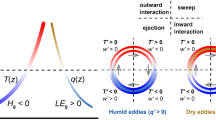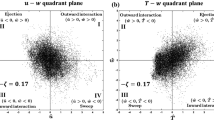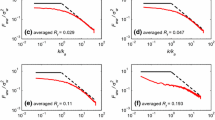Abstract
Based on observations over an alpine glacier, we investigate the turbulent flux dissimilarity between momentum and sensible heat transfer in a stably stratified katabatic flow. The flux correlation coefficient RF is employed as a measure of variable levels of the flux similarity, which are found to be modulated by the anisotropy of turbulence. In the katabatic wind regime over this glacier, heat is transported more efficiently than momentum. Based on quadrant analysis, the sweep–ejection differences in the flux fraction constitute turbulence characteristics in terms of the velocity aspect ratio, which unravel dissimilar transport of momentum and heat. Moreover, an innovative method is established for connecting quadrant analysis and cospectral analysis, whereby the hyperbolic quadrant hole size is coupled to the frequency underlying the fast Fourier transform. In extending applications of octant analysis, we introduce a hypothetical octant hole, whose size is solicited as a proxy for the amplitude scale of fluctuating fluxes. The contributions to \({R}_{F}\) can then be quantified for eddy structures that are associated with different amplitude scales. The katabatic flow structures identified from octant analysis differ in their behaviour so helping illuminate the outcome of flux dissimilarity. Exhibited as a statistical behaviour regardless of amplitude scale, along-wind rapid motions of heated air parcels can modify fractional contributions to the heat flux instead of the momentum flux, with reductions in \({R}_{F}\) related to decreasing heat-flux fractions. Besides, along-wind slow motions of cooled air parcels cannot modify the flux fractions for both momentum and heat. Thus, the flux dissimilarity due to low-speed low-temperature eddies cannot be explicable in terms of the flux fractions alone. These findings are an incipient step towards physical understanding of the turbulent flux dissimilarity for a stably stratified katabatic flow.










Similar content being viewed by others
References
Aksamit NO, Pomeroy JW (2018) The effect of coherent structures in the atmospheric surface layer on blowing-snow transport. Boundary-Layer Meteorol 167:211–233
Anderson PS, Neff WD (2008) Boundary layer physics over snow and ice. Atmos Chem Phys 8:3563–3582
Bsssanerjee S, Krahl R, Durst F, Zenger Ch (2007) Presentation of anisotropy properties of turbulence, invariants versus eigenvalue approaches. J Turb 8:N32. https://doi.org/10.1080/14685240701506896
Barthlott C, Drobinski P, Fesquet C, Dubos T, Pietras C (2007) Long-term study of coherent structures in the atmospheric surface layer. Boundary-Layer Meteorol 125:1–24
Berger BW, Davis KJ, Yi C, Bakwin PS, Zhao CL (2001) Long-term carbon dioxide fluxes from a very tall tower in a northern forest: flux measurement methodology. J Atmos Ocean Technol 18:529–542
Bewley GP, Chang K, Bodenschatz E (2012) On integral length scales in anisotropic turbulence. Phys Fluids 24:061702. https://doi.org/10.1063/1.4726077
Charrondière C, Brun C, Sicart J-E, Cohard J-M, Biron R, Blein S (2020) Buoyancy effects in the turbulence kinetic energy budget and Reynolds stress budget for a katabatic jet over a steep alpine slope. Boundary-Layer Meteorol 177:97–122
Chowdhuri S, McNaughton KG, Prabha TV (2019) An empirical scaling analysis of heat and momentum cospectra above the surface friction layer in a convective boundary layer. Boundary-Layer Meteorol 170:257–284
Chowdhuri S, Prabha TV (2019) An evaluation of the dissimilarity in heat and momentum transport through quadrant analysis for an unstable atmospheric surface layer flow. Environ Fluid Mech 19:513–542
Chowdhuri S, Prabha TV, Karipot A, Dharamraj T, Patil MN (2015) Relationship between the momentum and scalar fluxes close to the ground during the Indian post-monsoon period. Boundary-Layer Meteorol 154:333–348
Denby B (1999) Second-order modelling of turbulence in katabatic flows. Boundary-Layer Meteorol 92:67–100
Denby B, Smeets CJPP (2000) Derivation of turbulent flux profiles and roughness lengths from katabatic flow dynamics. J Appl Meteorol 39:1601–1612
Ding B, Yang K, Yang W, He X, Chen Y, Lazhu, Guo X, Wang L, Wu H, Yao T (2017) Development of a Water and Enthalpy Budget-based Glacier mass balance Model (WEB-GM) and its preliminary validation. Water Resour Res 53:3146–3178
Dupont S, Patton EG (2012) Momentum and scalar transport within a vegetation canopy following atmospheric stability and seasonal canopy changes: the CHATS experiment. Atmos Chem Phys 12:5913–5935
Dupont S, Rajot J-L, Labiadh M, Bergametti G, Lamaud E, Irvine MR, Alfaro SC, Bouet C, Fernandes R, Khalfallah B, Marticorena B, Bonnefond JM, Chevaillier S, Garrigou D, Henry-des-Tureaux T, Sekrafi S, Zapf P (2019) Dissimilarity between dust, heat, and momentum turbulent transports during aeolian soil erosion. J Geophys Res Atmos 124:1064–1089
Everard KA, Oldroyd HJ, Christen A (2020) Turbulent heat and momentum exchange in nocturnal drainage flow through a sloped vineyard. Boundary-Layer Meteorol 175:1–23
Fitzpatrick N, Radić V, Menounos B (2017) Surface energy balance closure and turbulent flux parameterization on a mid-latitude mountain glacier, Purcell Mountains. Canada Front Earth Sci 5:67. https://doi.org/10.3389/feart.2017.00067
Foken T, Wichura B (1996) Tools for quality assessment of surface-based flux measurements. Agric for Meteorol 78:83–105
Francone C, Katul GG, Cassardo C, Richiardone R (2012) Turbulent transport efficiency and the ejection-sweep motion for momentum and heat on sloping terrain covered with vineyards. Agric for Meteorol 162–163:98–107
Grachev AA, Leo LS, Di Sabatino S, Fernando HJS, Pardyjak ER, Fairall CW (2016) Structure of turbulence in katabatic flows below and above the wind-speed maximum. Boundary-Layer Meteorol 159:469–494
Guo X, Yang K, Zhao L, Yang W, Li S, Zhu M, Yao T, Chen Y (2011) Critical evaluation of scalar roughness length parametrizations over a melting valley glacier. Boundary-Layer Meteorol 139:307–332
Han G, Zheng XJ, Bo T (2017) Experimental investigation of turbulent transport of momentum and heat in the atmospheric surface layer. J Atmos Sol-Terr Phys 164:18–28
Hill RJ (1989) Implications of Monin-Obukhov similarity theory for scalar quantities. J Atmos Sci 46:2236–2244
Hock R (2005) Glacier melt: a review of processes and their modelling. Prog Phys Geogr 29:362–391
Horst TW, Doran JC (1988) The turbulence structure of nocturnal slope flow. Boundary-Layer Meteorol 45:605–616
Huang J, Katul G, Albertson J (2013) The role of coherent turbulent structures in explaining scalar dissimilarity within the canopy sublayer. Environ Fluid Mech 13:571–599
Kaimal JC, Finnigan JJ (1994) Atmospheric boundary layer flows: their structure andmeasurement. Cambridge University Press, Cambridge
Kaimal JC, Wyngaard JC, Izumi Y, Coté OR (1972) Spectral characteristics of surface-layer turbulence. Q J R Meteorol Soc 98:563–589
Katsouvas GD, Helmis CG (2008) On the temporal distribution of bursts and events in the stable marine atmospheric surface layer. Boundary-Layer Meteorol 127:395–411
Katsouvas GD, Helmis CG, Wang Q (2007) Quadrant analysis of the scalar and momentum fluxes in the stable marine atmospheric surface layer. Boundary-Layer Meteorol 124:335–360
Katul G, Hsieh C-I, Kuhn G, Ellsworth D, Nie D (1997a) Turbulent eddy motion at the forest-atmosphere interface. J Geophys Res Atmos 102:13409–13421
Katul G, Kuhn G, Schieldge J, Hsieh C-I (1997b) The ejection-sweep character of scalar fluxes in the unstable surface layer. Boundary-Layer Meteorol 83:1–26
Katul G, Poggi D, Cava D, Finnigan J (2006) The relative importance of ejections and sweeps to momentum transfer in the atmospheric boundary layer. Boundary-Layer Meteorol 120:367–375
Keylock CJ, Lane SN, Richards KS (2014) Quadrant/octant sequencing and the role of coherent structures in bed load sediment entrainment. J Geophys Res Earth Surf 119:264–286
Lee X, Finnigan J, Paw UKT (2004) Coordinate systems and flux bias error. In: Lee X, Massman W, Law B (eds) Handbook of micrometeorology: a guide for surface flux measurement and analysis. Kluwer, Dordrecht, pp 33–66
Li N, Balaras E, Wallace JM (2010) Passive scalar transport in a turbulent mixing layer. Flow Turbulence Combust 85:1–24
Li X, Bo T (2019) An application of quadrant and octant analysis to the atmospheric surface layer. J Wind Eng Ind Aerodyn 189:1–10
Li D (2019) Turbulent Prandtl number in the atmospheric boundary layer - Where are we now? Atmos Res 216:96–105
Li D, Bou-Zeid E (2011) Coherent structures and the dissimilarity of turbulent transport of momentum and scalars in the unstable atmospheric surface layer. Boundary-Layer Meteorol 140:243–262
Li D, Katul GG, Bou-Zeid E (2012) Mean velocity and temperature profiles in a sheared diabatic turbulent boundary layer. Phys Fluids 24:105105. https://doi.org/10.1063/1.4757660
Li D, Katul GG, Bou-Zeid E (2015a) Turbulent energy spectra and cospectra of momentum and heat fluxes in the stable atmospheric surface layer. Boundary-Layer Meteorol 157:1–21
Li D, Katul GG, Gentine P (2015b) The scaling of air temperature spectra in atmospheric surface layer flows. Q J R Meteorol Soc 142:496–505
Li D, Katul GG, Zilitinkevich SS (2015c) Revisiting the turbulent Prandtl number in an idealized atmospheric surface layer. J Atmos Sci 72:2394–2410
Litt M, Sicart J-E, Helgason W (2015) A study of turbulent fluxes and their measurement errors for different wind regimes over the tropical Zongo Glacier (16° S) during the dry season. Atmos Meas Tech 8:3229–3250
Łobocki L (2014) Surface-layer flux–gradient relationships over inclined terrain derived from a local equilibrium, turbulence closure model. Boundary-Layer Meteorol 150:469–483
Lu SS, Willmarth WW (1973) Measurements of the structure of the Reynolds stress in a turbulent boundary layer. J Fluid Mech 60:481–511
Lumley JL (1979) Computational modeling of turbulent flows. Adv Appl Mech 18:123–176
Mahrt L (1998) Stratified atmospheric boundary layers and breakdown of models. Theor Comput Fluid Dyn 11:263–279
Mahrt L (1999) Stratified atmospheric boundary layers. Boundary-Layer Meteorol 90:375–396
Mahrt L (2007) Weak-wind mesoscale meandering in the nocturnal boundary layer. Environ Fluid Mech 7:331–347
Mahrt L, Gibson W (1992) Flux decomposition into coherent structures. Boundary-Layer Meteorol 60:143–168
Marusic I, McKeon BJ, Monkewitz PA, Nagib HM, Smits AJ, Sreenivasan KR (2010) Wall-bounded turbulent flows at high Reynolds numbers: recent advances and key issues. Phys Fluids 22:065103. https://doi.org/10.1063/1.3453711
McMillen RT (1988) An eddy correlation technique with extended applicability to non-simple terrain. Boundary-Layer Meteorol 43:231–245
McNaughton KG, Laubach J (2000) Power spectra and cospectra for wind and scalars in a disturbed surface layer at the base of an advective inversion. Boundary-Layer Meteorol 96:143–185
Moore CJ (1986) Frequency response corrections for eddy correlation systems. Boundary-Layer Meteorol 37:17–35
Nadeau DF, Pardyjak ER, Higgins CW, Parlange MB (2013) Similarity scaling over a steep alpine slope. Boundary-Layer Meteorol 147:401–419
Nicholson L, Stiperski I (2020) Comparison of turbulent structures and energy fluxes over exposed and debris-covered glacier ice. J Glaciol 66:543–555
Nieuwstadt FTM (1984) The turbulent structure of the stable, nocturnal boundary layer. J Atmos Sci 41:2202–2216
Oldroyd HJ, Pardyjak ER, Higgins CW, Parlange MB (2016a) Buoyant turbulent kinetic energy production in steep-slope katabatic flow. Boundary-Layer Meteorol 161:405–416
Oldroyd HJ, Pardyjak ER, Huwald H, Parlange MB (2016b) Adapting tilt corrections and the governing flow equations for steep, fully three-dimensional, mountainous terrain. Boundary-Layer Meteorol 159:539–565
Poggi D, Katul G (2007) The ejection-sweep cycle over bare and forested gentle hills: a laboratory experiment. Boundary-Layer Meteorol 122:493–515
Pope SB (2000) Turbulent flows. Cambridge University Press, Cambridge
Raupach MR (1981) Conditional statistics of Reynolds stress in rough-wall and smooth-wall turbulent boundary layers. J Fluid Mech 108:363–382
Robinson SK (1991) Coherent motions in the turbulent boundary layer. Annu Rev Fluid Mech 23:601–639
Salesky ST, Katul GG, Chamecki M (2013) Buoyancy effects on the integral lengthscales and mean velocity profile in atmospheric surface layer flows. Phys Fluids 25:105101. https://doi.org/10.1063/1.4823747
Schaefer M, Fonseca-Gallardo D, Farías-Barahona D, Casassa G (2020) Surface energy fluxes on Chilean glaciers: measurements and models. Cryosphere 14:2545–2565
Schotanus P, Nieuwstadt FTM, De Bruin HAR (1983) Temperature measurement with a sonic anemometer and its application to heat and moisture fluctuations. Boundary-Layer Meteorol 26:81–93
Schmutz M, Vogt R (2019) Flux similarity and turbulent transport of momentum, heat and carbon dioxide in the urban boundary layer. Boundary-Layer Meteorol 172:45–65
Serafin S, Adler B, Cuxart J, De Wekker SFJ, Gohm A, Grisogono B, Kalthoff N, Kirshbaum DJ, Rotach MW, Schmidli J, Stiperski I, Večenaj Ž, Zardi D (2018) Exchange processes in the atmospheric boundary layer over mountainous terrain. Atmos 9:102. https://doi.org/10.3390/atmos9030102
Sfyri E, Rotach MW, Stiperski I, Bosveld FC, Lehner M, Obleitner F (2018) Scalar-flux similarity in the layer near the surface over mountainous terrain. Boundary-Layer Meteorol 169:11–46
Shi Y, Xia Z, Chen S (2016) A new identification method in sampled quadrant analysis for wall-bounded turbulence. Phys Fluids 28:061702. https://doi.org/10.1063/1.4954057
Smedman A-S, Bergström H, Högström U (1995) Spectra, variances and length scales in a marine stable boundary layer dominated by a low level jet. Boundary-Layer Meteorol 76:211–232
Smeets CJPP, Duynkerke PG, Vugts HF (1998) Turbulence characteristics of the stable boundary layer over a mid-latitude glacier. Part I: a combination of katabatic and large-scale forcing. Boundary-Layer Meteorol 87:117–145
Smeets CJPP, Duynkerke PG, Vugts HF (2000) Turbulence characteristics of the stable boundary layer over a mid-latitude glacier. Part II: pure katabatic forcing conditions. Boundary-Layer Meteorol 97:73–107
Smith T, Smith MW, Chambers JR, Sailer R, Nicholson L, Mertes J, Quincey DJ, Carrivick JL, Stiperski I (2020) A scale-dependent model to represent changing aerodynamic roughness of ablating glacier ice based on repeat topographic surveys. J Glaciol 66:950–964
Steiner AL, Pressley SN, Botros A, Jones E, Chung SH, Edburg SL (2011) Analysis of coherent structures and atmosphere-canopy coupling strength during the CABINEX field campaign. Atmos Chem Phys 11:11921–11936
Stiperski I, Calaf M (2018) Dependence of near-surface similarity scaling on the anisotropy of atmospheric turbulence. Q J R Meteorol Soc 144:641–657
Stiperski I, Calaf M, Rotach MW (2019) Scaling, anisotropy, and complexity in near-surface atmospheric turbulence. J Geophys Res Atmos 124:1428–1448
Stiperski I, Rotach MW (2016) On the measurement of turbulence over complex mountainous terrain. Boundary-Layer Meteorol 159:97–121
Stull R (1988) An introduction to boundary layer meteorology. Kluwer Academic Publishers, Dordrecht
Suzuki H, Suzuki K, Sato T (1988) Dissimilarity between heat and momentum transfer in a turbulent boundary layer disturbed by a cylinder. Int J Heat Mass Transf 31:259–265
Tyagi B, Satyanarayana ANV (2014) Coherent structures contribution to fluxes of momentum and heat during stable conditions for pre monsoon thunderstorm season. Agric for Meteorol 186:43–47
Volino RJ, Simon TW (1994) An application of octant analysis to turbulent and transitional flow data. J Turbomach-Trans ASME 116:752–758
Wallace JM, Eckelmann H, Brodkey RS (1972) The wall region in turbulent shear flow. J Fluid Mech 54:39–48
Wallace JM (2016) Quadrant analysis in turbulence research: history and evolution. Annu Rev Fluid Mech 48:131–158
Wang L, Li D, Gao Z, Sun T, Guo X, Bou-Zeid E (2014) Turbulent transport of momentum and scalars above an urban canopy. Boundary-Layer Meteorol 150:485–511
Xu B-Q, Wang M, Joswiak DR, Cao J-J, Yao T-D, Wu G-J, Yang W, Zhao H-B (2009) Deposition of anthropogenic aerosols in a southeastern Tibetan glacier. J Geophys Res 114:D17209. https://doi.org/10.1029/2008JD011510
Zou J, Zhou B, Sun J (2017) Impact of eddy characteristics on turbulent heat and momentum fluxes in the urban roughness sublayer. Boundary-Layer Meteorol 164:39–62
Acknowledgements
XG, ZG and LW are funded by the Second Tibetan Plateau Scientific Expedition and Research Program (Grant 2019QZKK0102); JH is funded by the National Research Foundation of Korea that is sponsored by the South Korean government (MSIT) (Grant NRF-2018R1A5A1024958). The software for wavelet analysis is available at http://atoc.colorado.edu/research/wavelets (University of Colorado Boulder) courtesy of Christopher Torrence and Gilbert P. Compo. Supporting data for the authors’ primary findings are publicly available at http://doi.org/10.6084/m9.figshare.14906526.
Author information
Authors and Affiliations
Corresponding author
Additional information
Publisher's Note
Springer Nature remains neutral with regard to jurisdictional claims in published maps and institutional affiliations.
Supplementary Information
Below is the link to the electronic supplementary material.
Rights and permissions
About this article
Cite this article
Guo, X., Yang, W., Gao, Z. et al. Katabatic Flow Structures Indicative of the Flux Dissimilarity for Stable Stratification. Boundary-Layer Meteorol 182, 379–415 (2022). https://doi.org/10.1007/s10546-021-00660-y
Received:
Accepted:
Published:
Issue Date:
DOI: https://doi.org/10.1007/s10546-021-00660-y




